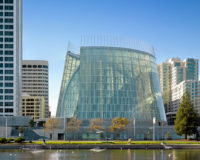This is a guidebook for a certain kind of travel aficionado—the one who wants to know which hotels architects with keen design minds favor. In surveying over 270 international practitioners, editor Sarah Miller came up with more than 1,200 recommendations. Oddly, this book includes no photos—only websites of the establishments. Nor are the hotels’ architects listed (even odder). Yet there are many surprises to discover in this compact compilation.
While Miller is not an architect or a hotelier, she has been steeped in those realms: her grandparents owned a hotel in London where she spent time growing up; her father, John Miller, practiced architecture in London with her stepmother, Su Miller, and her husband is the critic Deyan Sudjic, now director of London’s Design Museum. And the Oxford-educated writer and journalist was a former editor in chief of Condé Nast Traveller, UK edition.
According to the book, some little-known hotels attract a sizable following: a cluster of architects say they wish they had designed the Amangiri resort in Canyon Point, Utah, including Michel Rojkind, Tom Kundig of Olson Kundig, Bruce Kuwabara of KPMB Architects, and Enrique Norten of Ten Arquitectos. Amangiri is, says Daniel Libeskind, “worth the travel,” and Ron Radziner, of Marmol Radziner, and Deborah Berke also vote for it as a favorite desert retreat.
The design of Amangiri resulted from the collaboration of three architects: Marwan Al-Sayed, Wendell Burnette, and Rick Joy. Yet, strangely, Joy did not list it in his recommendations. Known for his modernist/vernacular style, Joy cites the stately Connaught in London, in the luxury category. Also playing against type, the edgy architect Charles Renfro of Diller Scofidio + Renfro suggests the elegantly traditional Carlyle Hotel for visitors to New York. Steven Holl, known for sculptural topographical forms, calls the quietly classic Raphael Hotel in Paris his “all-time favorite.” For the avant-garde Doriana and Massimiliano Fuksas, the Mediterranean Revival Beverly Hills Hotel is their first luxury choice. Carlo Ratti, who traffics in ultra-high-tech design, ranks the grand dame Bristol Hotel in Paris as his top place to stay. Not even modern architects follow the party line.
But, if you want to make a real discovery, look at the “best-kept secret” category. Paris’s Le Pavillon de la Reine, which fronts the Place des Vosges, is nominated by Craig Dykers of Snøhetta (but he forgot to say, “Don’t bother trying to reserve a room during Fashion Week”). And Norman Foster, so identified with steel and glass, considers the picturesque Inn at Little Washington in the foothills of the Blue Ridge Mountains of Virginia to fill the bill.
Some architects weren’t shy about nominating their own hotels for the guide: Kundig recommends his Rolling Huts, in Mazama, Washington, for a mountain destination, while Norten includes his Habita Hotel in Mexico City as a good urban choice. Marianne Kwok of Kohn Pedersen Fox looked to her contemporaries’ work: the PUBLIC Hotel on Manhattan’s Lower East Side, by Herzog de Meuron, is her “where I live” selection. Both Dan Wood of WORK/AC and Florian Idenburg of SO-IL elected Arcosanti, the utopian architectural and ecological commune/school in Arizona, founded by Paolo Soleri in 1970, as their pick for a desert resort. (It offers overnight accommodations but no amenities—even the wi-fi is spotty.) Farther off the beaten path is Annabelle Selldorf’s top choice, an abandoned mining camp turned spa—Dunton Hot Springs, in Dolores, Colorado.
With all these unexpected preferences, this quirky guide to getting inside the minds of certain architects and their best-loved haunts is well worth consulting before your next trip.







Post a comment to this article
Report Abusive Comment